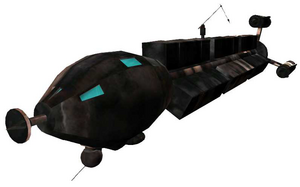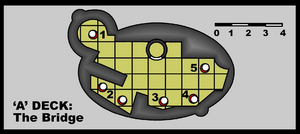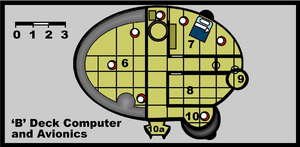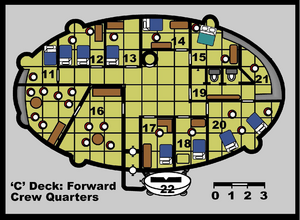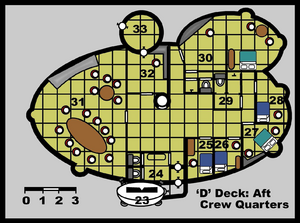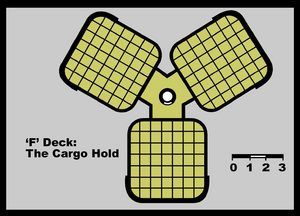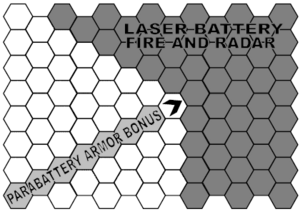East Indiaman
From Star Frontiers Network
Top:Star Frontiersman main page | Up: Star Frontiersman Issue 6 main index | Up: Starships main index
Revamped by Stuart Shaw

Editor’s Note: This article first appeared in the September 1984 issue of IMAGINE magazine. Stuart Shaw enjoyed that article and thought it could use some new art and some revamping. He did an amazing job. This article is the first in a potential series of articles showing some starship designs, complete with deck plans and exterior images, for players in the Star Frontiers game.
Knight Hawks is a really big toolset for the creation of starships, but one thing lacking in that set of rules is a repository of standard ships commonly found throughout the Frontier. Every ship has to be created from scratch. This article serves to correct that oversight. Future articles can include submissions from anyone... even if you’re not artistic enough to pull off the deck plans or images. We’re a pool of creative talent and we all have our role.
Page references are to the original texts, not the Digitally Remastered versions of those same books.
The East Indiaman Class is based on a size 10 hull. It has a beam of 39m of an overall length (including the drives) of 210m. The ship's only defensive system - a reflective hull - is provided as standard, as is a laser battery mounted in a chin turret.
East Indiamen are usually powered by three type B ion engines - these are usually de-rated military drives, or occasionally UPF-surplus drives. Launched from the airdock of Tallyman Associates (the designers) at Triad starport, a basic East Indiaman as described below costs Cr 1,330,000. If built by a licensed contractor at another Class I starport the cost of the basic ship rises to Cr 1,570,000.
Atomic drives can be fitted in place of the ion engines. This version, including an up-rated Drive program and deluxe astrogation package costs Cr 2.4 million. The ship's ADF is 3 with atomic drives. All other statistics remain the same.
The deck plans, side view and descriptions which follow in the sections below are for a typical cargo carrying East Indiaman. As such, the ship serves as an excellent example of what is delivered to a customer by Tallyman Associates. Naturally, customers and crews rapidly alter and add to the basic specifications to make a ship more like home.
Construction standards
The hull is made of poly-carbon and is capable of sustaining 200+2d100 points of structural damage at any point (portholes are made of armored plastic, and can take the same damage). Airlock hatches can take 200+d100 points of structural damage internally, breaching the bulkheads requires 50+2d10 points of damage. Unless noted otherwise, compartment doors are of heavy construction (c.f. Structural Points table; Alpha Dawn Expanded Rule Book p25).
Security Systems
The hull is fitted with skin sensors that are tied into the Installation (Ship) Security program. A full size camera system giving coverage of the entire ship is also fitted. The resulting video images may be displayed by any computer terminal on the ship. The Ship Security program also controls movement through a system of cardlocks.
Crew ID cards will open all airlock hatches and doors on the vessel, and allow use of the elevator. Access to the cabins and the Bridge is usually restricted to nominated crew members. When issued, passenger ID cards allow access to the passenger's cabin, the mess and the recreation lounge. The elevator cardlock will only allow access to decks where the user's ID card can open doors.
Although not mentioned in any Tallyman sales literature, there is an additional security system fitted. Built into both of the Life Support systems are tranquillizer devices that can be triggered from the Pilot's position on either Bridge. Anyone who is not wearing some form of protection – a space suit, an emergency suit or a gas mask – is treated as being in the burst radius of a doze grenade when either of these systems is activated. Usually only the Ship's master, pilot and engineer are told of the existence of this system.
Elevator
The central lift shaft is built to the same standards as the outer hull. It carries not only the personnel elevator that runs the entire length of the ship, but much of the vessel's 'central nervous system' as well. All the fiber-optic computer and intercom links and the main power and water supplies are buried within the walls of the shaft. A recessed ladder is also built into the side of the shaft for use in emergencies when the lift fails.
Cabins
All the cabins aboard an East Indiaman Freighter are similar in the fixtures and fittings provided. Each contains a bed locker or closet for each occupant, an intercom, a computer terminal (allowing access to the entertainment functions of the Communications program only), spacesuit storage facilities and an emergency suit for each occupant (see the section New Equipment section for further details of the emergency suit).
Crew
The minimum recommended number of crew beings required to run an East Indiaman is four - ship's master, pilot, astrogator, and engineer. Crew members would be expected to do more than one job. A more usual complement is seventhe exact breakdown of tasks varies from ship to ship - as this is large enough to allow some crew back up and small enough to be economic.
The ship's master is a designated crew member, often the pilot or the ship's owner, charged with overall management of the ship. The designated ship's master is granted a large number of user privileges on the computer - he or she is usually the only individual who can access any program from any part of the ship. UPF space regulations hold the ship's master responsible for safety and all other activities of the vessel.
Transposant Ship
Both governments and corporations have found it necessary to displace troublesome elements in the population, and the moving of these 'transposants' proved too expensive by normal commercial means.
A Transposant East Indiaman carries the nine modified cargo pods, each containing 2000 storage berths and the attendant life support equipment. Each ship can carry up to 18,000 transposant beings -political prisoners, commercial dissidents, criminals, enforced colonial Volunteers, and corporate labor transportees - to wherever they are required. The UPF also has an ion-drive Transposant East Indiaman - UPFS S'sor - for relocating troops between bases.
A Deck: The Bridge
Astrogation: Only the basic astrogation equipment package is provided on an East lndiaman, as these ships are intended to fly regular, well charted routes. The computer terminal allows access only to the Astrogation, Analysis and Information Storage programs
Pilot's Position: All ship control functions can be performed from this one seat, as the helm and other controls - including cargo and engine jettison controls - are within easy reach (engine jettison controls are included only if the ship has atomic drives – cargo jettison controls are standard). In addition to the master control panel, the pilot’s position allows use of the videocom radio, the intercom system, the hull camera system, the radar and the hull skin sensor readouts.
All programs may normally be accessed.
The adjacent console duplicates some of the controls, allowing a co-pilot to monitor the ship's functions as well. Computer access from this console is restricted to the Drive, Alarm, Damage Control and Communications programs.
Communications Position: Usually unoccupied, this console is the central control for the ship's communication and detection equipment - the videocom radio, the intercom system, the hull camera system, the radar and the hull skin sensors Only from here can computer data be transmitted (for example, cargo manifests too customs inspection ship) to an external system through the videocom radio.
Fire Control Position: This is the primary control position for the chin mounted laser battery (10 & 10A) and control of the weapon is normally assigned to this position. A character with Energy Weapons Gunnery skill may use his or her subskills from this console to influence the success of any fire from the laser battery.
Engineer's Monitoring Position: This console allows indirect monitoring of the ship's engineering functions through Drive, Alarm and Damage Control programs. The console also includes a separate intercom link (not connected to the central intercom) to the workpods, the engineering decks (E and G Decks) and the spacesuit radios.
B Deck: Computer and Avionics
Computer Compartment: This compartment is built to hull standards, and the door is fortified Only the ship's master, the pilot and the engineer can enter and a security code must be entered at the Pilot's position (2) before the door will open.
The compartment contains the ship's computer, a level 4 machine, and the bulk of the ship's avionics - the electronic, detection and communications equipment This includes the hull camera control, the radar installation, the astrogation electronics package and the videocom system
The computer runs all the programs needed on the ship These include Drive, Computer Lockout, Astrogation, Alarm, Damage Control, Cargo handling, Laser Battery, Skin Sensor, Life Support Installation (Ship) Security 4, Commerce 2, Communrcatrons-2, Computer Security-3, Information Storage-3, Bureaucracy 3, and Analysis 4 programs, which are supplied as standard. There is sufficient space to expand the computer to a maximum of 500 function points
Pilot's Cabin: The pilot's cabin is deliberately placed within the ship as close as possible to the Bridge. In addition to the usual fixtures, the pilot's cabin has its own toilet facilities and a small automatic galley that can provide hot drinks and quick snacks. The Computer terminal is linked directly to the Drive and Alarm programs and is programmed to alert the off-duty pilot to any major malfunction in the ship's systems.
Arms Locker: The Arms Locker will only open under the same circumstances as the Computer Compartment (6) When delivered from the airdock, the arms locker is not usually supplied with weaponry, but a small weapons workbench is fitted.
Escape Pod: The ship's one escape pod is intended for the pilot's use. In an emergency, the pilot is expected to remain at the control console until the last possible moment and then escape aboard this pod
'Secondary Fire Control, Laser Battery and Radar Mounting: All the functions of the Fire Control position (4) on the bridge are duplicated here, with the added thrill of being able to watch the laser battery in action.
Major repairs to the laser battery or radar mounting (I DA) can only be made from outside the ship, but some minor circuitry can be reached from inside If the laser battery or radar system is damaged in combat, there is a 15% chance that a repair can be made from within the ship.
C Deck: Forward Crew Quarters
Crew Cabins: Two of the cabins are for double occupancy, one (12) has two single berths, while the other (15) has a double bed installed. The beds are bolted to the floor but can be made to lower into the floor with the push of a button, a decorative panel (resembles an area rug) will move to cover the compartment. The decorative panel is padded for comfort, so crewmen can enjoy a private area to exercise as needed.
Recreation Lounge: The recreation area has a large screen computer terminal linked to the entertainment section of the Communications program. A small automatic galley, capable of providing drinks and snacks, is also fitted. In emergencies, this area can be converted into adequate - if somewhat uncomfortable - passenger space.
Guard Cabins: Cargo guards, provided by the cargo owners) to prevent the ship and cargo being 'lost', are allocated special cabins. These differ from normal cabins in that the doors are fortified, a weapon power clip/pack recharging station is provided and the computer terminal is allowed access to Analysis, Information Storage, Commerce, and Installation Security programs
Toilets and Shower: The toilets and shower are standard space-going models, designed for use in zero gravity conditions
Sick Bay & Dispensary Allocation: These two compartments are intended for use as a sick bay and medical office. An augmented (with a complete set of spare drugs) medkit is included when the ship is launched, along with two beds and a computer terminal.
Lifeboat: The lifeboat is a standard model (see Knight Hawks Campaign Book p 17), streamlined for planetary landings, and it has a primitive autopilot.
D Deck: Aft Crew Quarters
Lifeboat: Identical to the lifeboat on 'C' Deck (22).
Toilets: The toilet is designed for use in zero gravity conditions as well as in the artificial gravity of ship acceleration or deceleration.
Guard Cabins: Identical in all respects to guard cabins 17 & 18 (‘C’ Deck).
Cabins: One of these cabins (27) is equipped for double occupancy with a double bed, while the other has a single berth.
Toilet and Shower: The toilet and shower are standard space-going models, identical to those on 'C' Decks (19).
Owner's or Master's Cabin: This is the most comfortably appointed cabin on the entire ship, and is usually decorated to suit the owner’s style. The cabin has its own shower and toilet facilities, is fitted with a g-size bed, and has an automatic galley that serves any meal within its programming (the programming can be varied to suit the user's requirements). When not in use by the owner or ship's master, this cabin can be used as first class passenger accommodation.
Crew Mess Area: The mess area has the largest galley on board the ship, capable of providing any good quality standard food- or at least a reasonable imitation. The computer terminal in here is, unless there are passengers aboard, always linked to the Alarm and Installation Security programs and set to alert any crew members should an emergency occur.
Forward Airlock Compartment: In addition to a simple manual control panel for the airlock, this compartment also contains a dozen spacesuit lockers. A rack for suits storing rocket packs is fitted, along with a shower unit for cleaning of any contaminating material.
Forward Airlock: The forward airlock is used for passenger and crew transfers - whether in a station dock or between ships in flight.
E Deck: Forward Engineering Deck
Secondary (Emergency) Bridge: The door to this compartment is fortified, and the cardlock will only open for the ships master, pilot or the engineer. All the functions of the bridge (A Deck) are duplicated, but to prevent the ship from being hi-jacked, the computer will only accept commands from here if those commands have been authorized by the ship’s master or the pilot. However, the computer’s installation Security program will automatically accept the secondary bridge as a valid control centre if ‘A’ Deck is no longer functional ( e.g. if the Damage Control Program reports that the hull has been breached, or the Life Support program reports that the bridge is in vacuum ).
Middle Airlock: This hatchway is usually used for the loading of passenger luggage and small items f cargo that must be carried in a pressurized environment. Unless the ship’s master has authorised the transfer of luggage with the Installation Security program, this airlock will be locked - and the crew ID cards will not activate the cardlock.
Forward Utility Access: The power, water and air supply for the forward decks of the ship can all be serviced in this compartment. The majority of the compartment is taken up with the circuitry for these functions, and - most importantly of all - the back-up life support unit (also see Security Systems).
This unit is not controlled directly by the ships main computer, but has its own designated processor ( a small level 1 computer running only a Life Support program ). The back-up LSU is normally used only in emergencies, but with both life support units running, an East Indiaman can carry a maximum of 70 beings, including the crew. Conditions in this situation would not be pleasant, but everybody would survive.
Cargo Arm Control: The computer terminal at this location is modified to include a joystick controller for the cargo loading arm (48) and release controls for the cargo pods - either ‘soft’ release, or to jettison the cargo. The terminal also has automatic access to the computer commerce program. The compartment is only used when cargo is being moved while the ship is docked, or as a security station because of the view of the outer hull.
Luggage Space: This is simply a pressurized hold for any luggage or delicate cargoes. It is normally kept locked during flights.
F Decks: Cargo Decks
Cargo Decks: The nine cargo bays or pods on board an East Indiaman are all 14 meters square and 60 meters high and are arranged in groups of three around the central ‘spine’ of the ship - giving three ‘cargo stacks’. The entire outer half of the cargo pod can be swung open to facilitate loading and unloading and, as a result, the standard cargo pods are not pressurized.
The cargo pods have no connection (other than simple monitoring devices) with the interior of the ship, and are detachable - in emergencies they can be jettisoned from the pilots position (2) on the bridge or Cargo Arm Control (37). This makes East Indiaman ideal for carrying high risk dangerous loads. Jettisoning pods takes 10 turns (one minute), and the jettisoning ship must change course after doing so to distance itself from the cargo pods.
Many of the larger corporations that own East Indiamen do not bother to unload individual pods from ships that are on regular scheduled flights - the entire pod is simply removed and replaced by a cargo pod containing the manifest for the ship’s next destination. This minimizes the amount of time that a ship must spend in dock, as replacing a pod takes two hours. Pods that are part of the same group of three in a deck may no be worked on simultaneously.
G Deck: Cargo Decks
Workshop: The workshop contains sufficient tools to carry outmost running repairs to the ship -the equivalent of a robcomkit, a techkit and an engineer's toolbox - although no inssuit is provided. A laser powertorch -and a bench mounting to turn it into a drill or lathe cutter is also included in the standard workshop fittings, as is a power backpack Normally the laser powertorch is plugged directly into the ship's power supply when used in here.
Workpods: Two workpods (see the Knight Hawks Campaign Book p30) are fitted as standard. Whenever a workpod is used and then repositioned in its launch cradle, diagnostic checks will be carried out by the ship's computer and the pod will be refuelled if this is required. Any repairs that are must be carried out on the pod will be displayed on the engineer's monitoring terminal on the Bridge(5) or here on G Deck (45).
Main Life Support Unit: This unit is run by the computer and is the one that is normally in operation This one unit can supply the air, food and water requirements of up to 35 beings, although conditions would be somewhat crowded
Computer Parabatteries: These are a final emergency backup system (one type 4 and one type 3 parabattery) to enable the computer to function - in a severely impaired way - even if the main parabatteries of the ship are exhausted If this system becomes the only power source for the computer it will suspend all the programs except for the Life Support and Communications programs.
Aft Airlock: The airlock has a simple manual control panel. A rack for storing rocket packs is fitted, along with a shower unit for suit cleaning Three rocket packs plus refills are provided by the ship's builders. On ships with atomic drives two engineering inssuits are also provided
Engineering Monitoring: This console monitors all of the engineering functions of the ship through the Drive, Alarm and Damage Control programs. The serviceability of other ship systems - such as the computer, workpods. camera system and the like -is also displayed here. The console also includes a separate intercom link (not connected to the ship's central intercom) to the workpods, the forward engineering deck, the engineer's monitoring position (5) on the Bridge and the spacesuit radios.
External Hull Features
Drive Access: The drive access tunnels are built into the engine struts and allow superficial inspection of the engine components and fuel tanks. Major repairs hive to be made from outside the ship. Aboard some ships the keel engine strut has been modified to include a cubic metre of storage space, suitable for smuggling small very high value illicit cargoes
Main Parabatteries: The main parabatteries provide all the ship's power when the drives are off and the ship is not connected to an external power source (in an airlock for example). These batteries are the equivalent 15 type 4 parabatteries (a total power store of 60,000 SEU) and are automatically recharged when the drives are operational.
Because of their placement within the ship, the parabatteries have an additional use as stern armor. When an East Indiaman is fired on from directly astern, the first 15 points of hull damage may be taken as hits upon the batteries. The equivalent power storage capability of one type 4 parabattery is lost for each point of hull damage taken in this fashion.
Cargo Loading Arm: The cargo loading arm is installed on a 35 meter diameter circular track that runs around the spine of the ship between the first and second set of cargo bays. From here, the cargo arm can be extended to reach into any of the cargo pods-taking ten hours to load or unload the entire hold - or it can assist in releasing a pod, reducing the time needed to do this to one hour.
Referee's Notes
In Knight Hawks game terms all standard East Indiamen have the following statistics.
| Standard East Indiaman (Freighter) | |
| Hull Points | 50 |
| Weaponry | Laser Battery |
| Defenses | Reflective Hull |
| Damage Control Rating (DCR) | 50 |
| Acceleration/ Deceleration Factor (ADF) | 1 |
| Maneuver Rating (MR) | 3 |
You can have any number of Knight Hawks-based scenarios having to do with the East Indiaman Freighter. On the page which follows, you’ll notice a new Knight Hawks scenario.
It’s common for freighters to have a military escort of some nature, but only when the vessel is carrying important cargo. In other cases, the “F” deck is replaced by crew compartments and the freighter becomes a make-shift troop transport, ferrying troops from location to location.
Design Faults on the East Indiaman Class
There are a number of design faults in the East Indiaman class that characters should not find out about, except through bitter experience. The escape pod (9) is too far away from the Bridge to be reached in a convenient time. If anyone attempts to escape from the Bridge by this route in an emergency (see Escaping from Destroyed Ships, Knight Hawks Campaign Book p37) the referee should secretly roll 2d10 This is the extra time in six-second turns that it takes the elevator to reach the bridge and then bring the character back down to 'B' Deck.
The chin mounted laser battery (10A) is so placed that it is incapable of firing on a target that is 'above' the ship or behind it. In terms of the Knight Hawks board game, this means that the laser batteries restricted to firing at targets within the shaded area of the diagram. Because it is mounted in the same place, the radar system can only 'see’ objects that fall within the same zone

